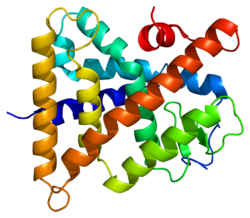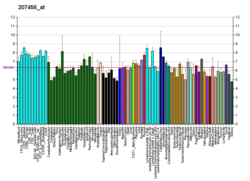Hepatocyte nuclear factor 4 gamma
Hepatocyte nuclear factor 4 gamma (HNF4G) also known as NR2A2 (nuclear receptor subfamily 2, group A, member 2) is a nuclear receptor that in humans is encoded by the HNF4G gene.[5][6][7]
Function
[edit]HNF4G is a transcription factor that has been shown to play a significant role in intestinal epithelial cell differentiation and function. Research using integrative multi-omics analysis of intestinal organoid differentiation has revealed that HNF4G acts as a master regulator of gene regulation in differentiation towards the enterocyte lineage.[8] The study demonstrated widespread binding to promoters and enhancers that are activated in enterocytes, and that the loss of Hnf4g results in a partial loss of enterocyte differentiation, indicating its importance in maintaining the enterocyte lineage.
See also
[edit]References
[edit]- ^ a b c GRCh38: Ensembl release 89: ENSG00000164749 – Ensembl, May 2017
- ^ a b c GRCm38: Ensembl release 89: ENSMUSG00000017688 – Ensembl, May 2017
- ^ "Human PubMed Reference:". National Center for Biotechnology Information, U.S. National Library of Medicine.
- ^ "Mouse PubMed Reference:". National Center for Biotechnology Information, U.S. National Library of Medicine.
- ^ "Entrez Gene: HNF4G hepatocyte nuclear factor 4, gamma".
- ^ Drewes T, Senkel S, Holewa B, Ryffel GU (March 1996). "Human hepatocyte nuclear factor 4 isoforms are encoded by distinct and differentially expressed genes". Molecular and Cellular Biology. 16 (3): 925–931. doi:10.1128/mcb.16.3.925. PMC 231074. PMID 8622695.
- ^ Wisely GB, Miller AB, Davis RG, Thornquest AD, Johnson R, Spitzer T, et al. (September 2002). "Hepatocyte nuclear factor 4 is a transcription factor that constitutively binds fatty acids". Structure. 10 (9): 1225–1234. doi:10.1016/S0969-2126(02)00829-8. PMID 12220494.
- ^ Lindeboom RG, van Voorthuijsen L, Oost KC, Rodríguez-Colman MJ, Luna-Velez MV, Furlan C, et al. (June 2018). "Integrative multi-omics analysis of intestinal organoid differentiation". Molecular Systems Biology. 14 (6): e8227. doi:10.15252/msb.20188227. PMC 6018986. PMID 29945941.
Further reading
[edit]- Plengvidhya N, Antonellis A, Wogan LT, Poleev A, Borgschulze M, Warram JH, et al. (October 1999). "Hepatocyte nuclear factor-4gamma: cDNA sequence, gene organization, and mutation screening in early-onset autosomal-dominant type 2 diabetes". Diabetes. 48 (10): 2099–2102. doi:10.2337/diabetes.48.10.2099. PMID 10512380.
- Ozeki T, Takahashi Y, Nakayama K, Funayama M, Nagashima K, Kodama T, et al. (January 2003). "Hepatocyte nuclear factor-4 alpha/gamma and hepatocyte nuclear factor-1 alpha as causal factors of interindividual difference in the expression of human dihydrodiol dehydrogenase 4 mRNA in human livers". Pharmacogenetics. 13 (1): 49–53. doi:10.1097/00008571-200301000-00007. PMID 12544512.







